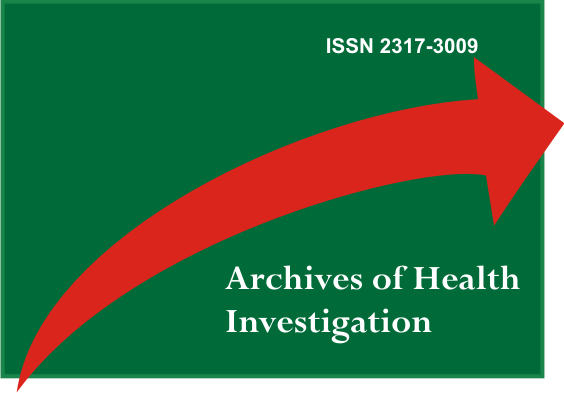Antimicrobial Activity of Plants Infusions on Oral Fusobacteria and their Adherence to Human Erythrocytes
DOI:
https://doi.org/10.21270/archi.v2i1.80Resumo
Periodontal disease is the result of the interrelationship between microbiotic aggression and the host’s organic defence. Amongst the microorganisms involved in periodontopathies, Fusobacterium nucleatum is conspicuous by establishing a link between the initial and final colonizers, besides producing toxic compounds and adhering to the host’s cells. Control of bacterial biofilm can be achieved by use of chemical agents, many of which extracted from plants. Thus the object of this study was to evaluate the inhibitory activity in vitro of some teas, generally taken in a normal diet, on Fusobacterium nucleatum and your adherence to host’s cells. Minimum inhibitory and bactericidal concentrations were established and haemagglutinative test in microplaques was effected. It was ascertained that all plant extracts have inhibitory activity and that infusions of Camellia sinensis (black tea and green tea), Mentha piperita (mint) and Pimpinella anixem (aniseed) added to the bacteria/erythrocyte compound reduced significantly the adherence of microorganisms.Keywords: Dental Plaque; Periodontitis; Disease Prevention; Plant Extracts; Hemagglutination; Cell Adhesion.
Downloads
Referências
Kolembrander PE, London J. Adhere today, here tomorrow; oral bacterial adherence. J Bacteriol. 1993; 175:3247-52.
Khocht A, Yaskell T, Janal M, Turner BF, Rams TE, Haffajee AD, et al. Subgingival microbiota in adult Down syndrome periodontitis. J Periodontal Res. 2012; 47:500-7.
Settem RP, El-Hassan AT, Honma K, Stafford GP, Sharma, A. Fusobacterium nucleatum and Tannerella forsythia induce synergistic alveolar bone loss in a mouse periodontitis model. Infect Immun. 2012; 80:2436-43.
Polak D, Shapira L, Weiss EI, Houri-Haddad Y. The role of coaggregation between Porphyromonas gingivalis and Fusobacterium nucleatum on the host response to mixed infection. J Clin Periodontol. 2012; 39:617-25.
Ozaki M, Miyake Y, Shirakawa M, Takemoto T, Okamoto H, Suginaka H. Binding specificity of Fusobacterium nucleatum to human erythrocytes, polymorphonuclear leukocytes, fibroblasts, and HeLa cells. J Periodontal Res. 1990; 25:129-34.
Falker Jr. WA, Hawley CA. Hemagglutinating activity of Fusobacterium nucleatum. Infect Immun. 1977; 15:230-8.
Maciel MAM, Pinto AC, Veiga JR VF. Plantas medicinais: a necessidade de estudos multidisciplinares. Quim Nova. 2002; 25:429-38.
Park AM, Dong Z. Signal transduction pathways: target for green and black tea polyphenols. J Biochem Mol Biol. 2003; 36:66-77.
Ooshima T, Minami T, Aono W, Tamura Y, Mamada S. Reduction of dental biofilm deposition in human by oolong tea extract. Caries Res. 1994; 28:146-9.
Sutter VL, Barry AL, Wilkins TD, Zabransky RJ. Collaborative evaluation of a proposed reference dilution method of susceptibility testing of anaerobic bacteria. Antimicrob Agents Chemother. 1979; 16:495-502.
Allen-Vercoe E, Strauss J, Chadee K. Fusobacterium nucleatum. An emerging gut pathogen? Gut Microbes. 2011; 2:294-8.
Sugawara S, Uehara A, Tamai R, Takada H. Innate immune responses in oral mucosa. J Endotoxin Res. 2002; 8:465-8.
Brighenti FL, Luppens SB, Delbem AC, Deng DM, Hoogenkamp MA, Gaetti-Jardim Jr E et al. Effect of Psidium cattleianum leaf extract on Streptococcus mutans viability, protein expression and acid production. Caries Res. 2008; 42:148-54.
Menezes TEC, Delbem ACB, Brighenti FL, Okamoto AC, Gaetti-Jardim E Jr. Protective efficacy of Psidium cattleianum and Myracrodruon urundeuva aqueous extracts against caries development in rats. Pharm Biol. 2010; 48:300-5.
Gaetti-Jardim JR E, Landucci LF, Arafat OKK, Ranieri RV, Ramos MMB, Ciesielski FIN, et al. Antimicrobial activity of six plant extracts from the Brazilian savanna on periodontal pathogens. Int J Odontostomat. 2011; 5:249-56.
Nwaokorie F, Coker A, Ogunsola F, Gaetti-Jardim JR E, Gabriel O, Patricia A, et al. Antimicrobial activities of Garcinia kola on oral Fusobacterium nucleatum and biofilm. African J Microbiol Res. 2010; 4:509-14.
Hamilton-Miller JMT. Antimicrobial properties of tea (Camellia sinensis L.). Ant Agent Chemother. 1995; 39:2375-7.
Ikigai HT, Nakae T, Hara Y, Shimamura T. Bactericidal catechins damage the lipid bilayer. Biochim Biophys Acta. 1992; 1147:132-6.
Nakane H, Ono K. Differential inhibitory effects of some catechin derivatives on the activities of human immunodeficiency virus reverse transcriptase and cellular deoxyribonucleic and ribonucleic acid polymerases. Biochem. 1990; 29:2841-5.
Toda M, Okubo S, Ikigai H, Shimamura T. Antibacterial and anti-hemolysin activities of tea catechins and their structural relatives. Nippon Saikingaku Zasshi. 1990; 45:561-6.
Falkler Jr. WA, Lai R, Vincent JW, Dober L, Spiegel C, Hayduk S. The elisa system for measuring antibody reactive to Fusobacterium nucleatum in the sera of individuals with chronic periodontitis. J Periodontol. 1982; 53:762-6.
Ooshima T, Minami T, Aono W, Izumitani A, Sobue S, Fujiwara T, et al. Oolong tea polyphenols inhibit experimental dental caries in SPF rats infected with mutans streptococci. Caries Res. 1993; 27:124-9.
Könönen E, Asikainen S, Jousemies-Somer H. Relationship between oral Gram- negative anaerobic bacteria in saliva of the mother and the colonization of her edentulous infant. Oral Microbiol Immunol. 1992; 7:273-6.
Oyston PC, Handley PS. Surface structures, haemagglutination and cell surface hydrophobicity of Bacteroides fragilis strains. J Gen Microbiol 1990; 136: 941-48.


